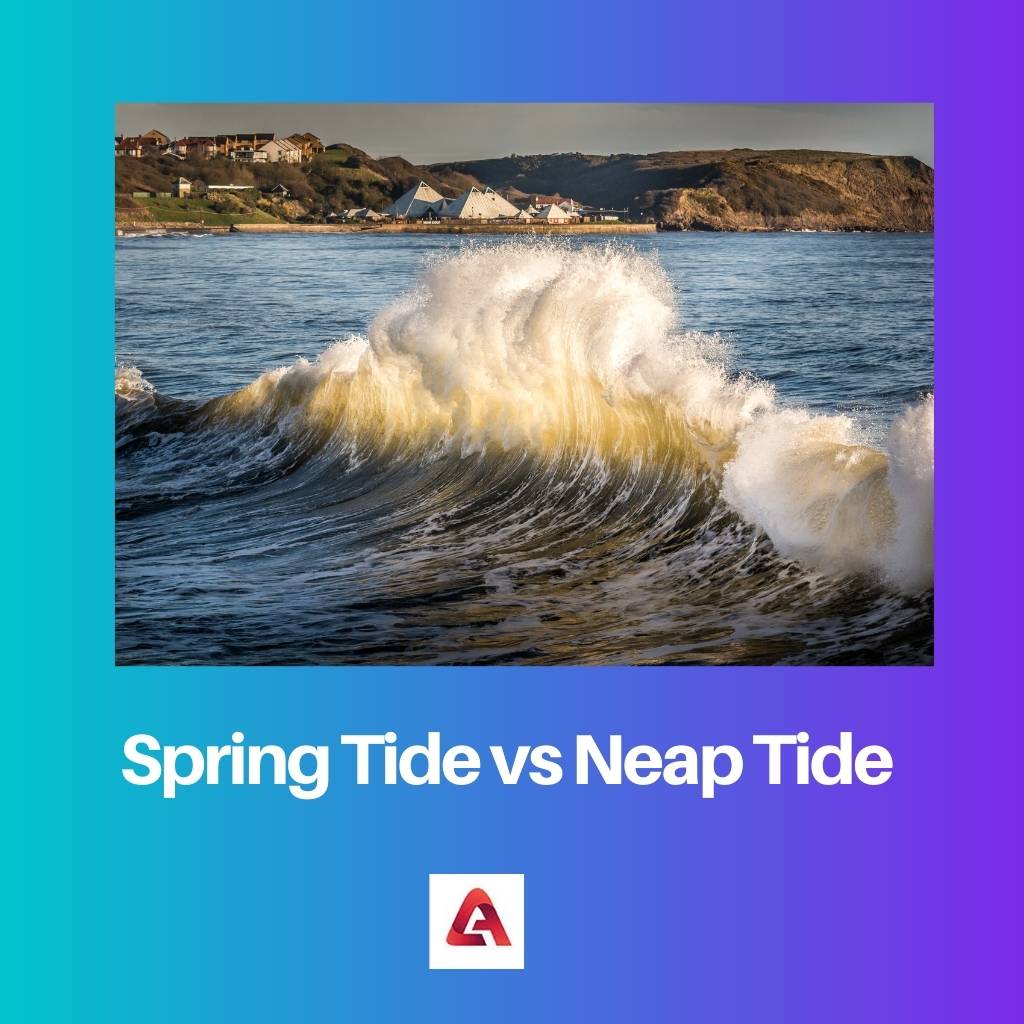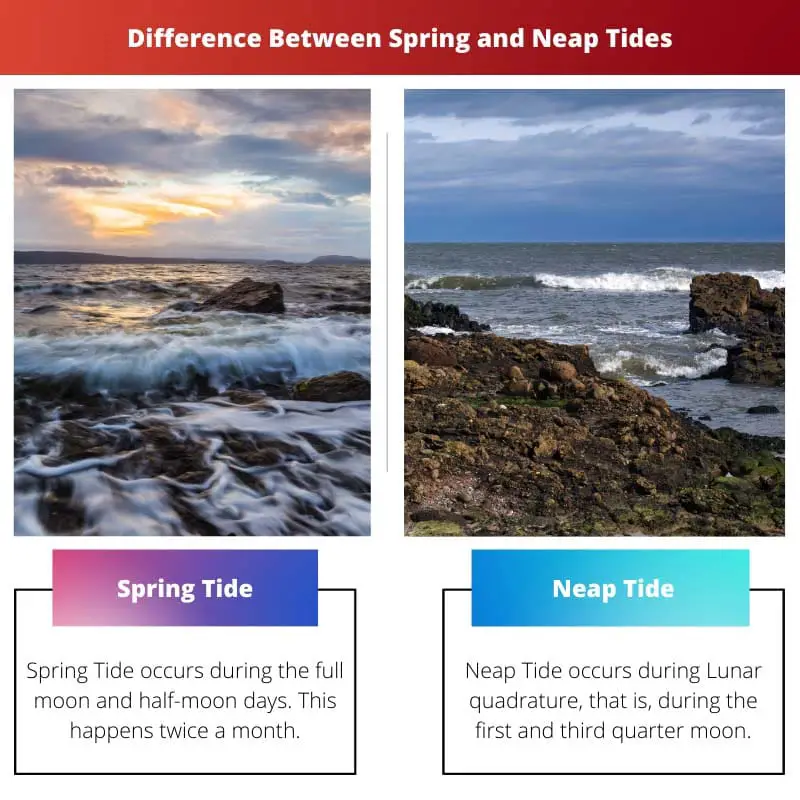Spring Tide has a more definite tidal range, whereas Neap Tides have a less definite tidal range. Although Spring Tides and Neap Tides are both types of Tides and hence, have some similar features, they differ from each other in quite a lot of ways.
Key Takeaways
- Spring tides occur when the sun, moon, and Earth align, resulting in higher and lower tides.
- Neap tides happen when the sun and moon form a right angle to the Earth, producing less extreme tidal ranges.
- Spring and neap tides occur twice a month, alternating approximately every two weeks.
Spring Tide vs Neap Tide
The difference between Springtide and a Neap tide is that the difference between a high tide for a Spring tide and a low tide for a Spring tide is always greater than usual. On the other hand, the difference between high tide for a Neap tide and low tide for a Neap Tide is lower than usual.

Twice a month, during the full moon and new moon days, the moon and sun work together, in alignment, to exert a maximum pull on the oceans. This results in the formation of Spring tides.
As the gravitational pull performed by both the moon and the sun gets added together, a more definite tidal range- low tides being lower than usual and high tides being stronger than usual is formed. Spring Tide gets its name because of its ‘springing’ nature throughout.
Neap tides are caused by the sun and moon’s gravitational pulls opposing one another. This takes place seven days after a Spring Tide, during the first and third quarter moon. The sun and moon are positioned at ninety degrees to one another during this time.
As the gravitational pull performed by both the moon and run work against each other, the tugging gets weakened, less definite tidal range- low and high tides being less definite than usual, is formed.
Comparison Table
| Parameters of Comparison | Spring Tide | Neap Tide |
|---|---|---|
| Occurrence | Spring Tide occurs during the full moon and half-moon days. This happens twice a month. | Neap Tide occurs during Lunar quadrature, that is, during the first and third quarter moon. |
| Origin | The Spring Tide originates when twice a month, during the full moon and new moon days, the moon and sun work together, in alignment, to exert a maximum pull on the oceans. This gives rise to giant tides known as Spring Tide. | Neap tides are caused by the sun and moon’s gravitational pulls opposing one another. This takes place seven days after a Spring Tide, during the first and third quarter moon. The sun and moon are positioned at ninety degrees to one another during this time. |
| Gravity | The gravitational pull of the sun and the moon gets added together because the moon and the sun are in the same direction. | The gravitational pull performed by both the moon and sun opposes each other because the sun, moon, and earth are positioned at ninety degrees from each other. |
| High and Low Tides | Since the gravitational pull of both moon and sun gets added together, the high tides are higher and stronger than normal, and the low tides are lower than usual. | In the case of Neap Tides, as the moon and sun exert opposing pulls, the tugging is lessened, and hence, a less definite tidal range resulting in a higher low and lower high tides is formed. |
| Tidal Range | The gravitational pull of both moon and sun gets added together, and a more definite or the greatest tidal range is formed. | As the moon and sun exert opposing pulls, the tugging is lessened, and a less definite or the lowest tidal range is formed. |
What is Spring Tide?
Twice a month, during the full moon and new moon days, the moon and sun work together, in alignment, to exert a maximum pull on the oceans. This results in the formation of Spring tides.
The gravitational pull of both moon and sun gets added together, and a more definite or the greatest tidal range is formed.
As the gravitational pull performed by both the moon and the sun gets added together, a more definite tidal range- low tides being lower than usual and high tides being stronger than usual is formed.
Spring Tides are giant tides, and they get their name because of their ‘springing’ nature throughout.

What is Neap Tide?
Neap tides are caused by the sun and moon’s gravitational pulls opposing one another. This takes place seven days after a Spring Tide, during the first and third quarter moon. During this time, the sun and moon are positioned at ninety degrees to one another.
As the moon and sun exert opposing pulls, the tugging is lessened, and a less definite tidal range- low and high tides being less definite than usual, is formed. Neap Tides are moderate and low tides.

Main Differences Between Spring and Neap Tides
- Spring Tide occurs during the full moon and half-moon days, whereas Neap Tide occurs during the Lunar quadrature, that is, during the first and third quarter moon.
- The Springtide originates when twice a month, during the full moon and new moon days, the moon and sun work together, in alignment, to exert a maximum pull on the oceans. This gives rise to giant tides known as Spring Tides, whereas Neap Tides are formed when the sun and the moon exert opposing pulls, and the tugging is lessened. This takes place seven days after a Spring Tide when the sun and moon are positioned at ninety degrees to one another.
- In the case of Spring Tide, the moon and the sun are in the same direction. Hence, the gravitational pull of the sun and the moon gets added together. On the other hand, in the case of Neap Tides, as the moon and sun exert opposing pulls, the tugging is lessened, and a less definite tidal range is formed because, during this time, the sun and moon are positioned at ninety degrees to one another.
- In the case of Spring tides, a more definite tidal range is formed, whereas, in the case of Neap Tides, a less definite tidal range is formed.
- Since, in the case of Spring Tides, the gravitational pull of both moon and sun gets added together, the high tides are higher and stronger than normal, and the low tides are lower than usual. On the other hand, in the case of Neap Tides, as the moon and sun exert opposing pulls, the tugging is lessened, and hence, a less definite tidal range resulting in higher low and lower high tides is formed.


This article has increased my knowledge on the topic.
I share your sentiments.
Great information. I was always curious about this topic and now I feel like I have a clear understanding of the differences between the two.
The article was comprehensive and easy to understand, thank you.
The comparison table helped visualize the differences in a clear manner.
The table was very helpful, I agree.
I appreciate the detailed explanation provided in the post.
I fully agree with you.
I really enjoyed reading this post.
I have learned a lot from reading this article.
The article provided a clear overview of spring and neap tides. Great job!
I couldn’t agree more. I feel like I have a thorough understanding of the topic now.
I never fully understood the difference between Spring tides and Neap tides, but this post provided a clear explanation.
I was in the same boat, but I feel much more informed now.
I have definitely learned something new today. Thank you.
The article was very informative and well-written.
The details provided were exceptional.
I couldn’t agree more.
Thank you for the detailed explanation of spring tides and neap tides, it was very informative.
This was a very fascinating piece of information. I really enjoyed reading it.
I agree, this was a very informative post.
The science behind the spring and neap tides was well explained in the post.
It sure was.